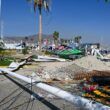Why nuclear energy is not the answer
By Arjun Makhijani, September 8, 2011
Nuclear power proponents claim:
- It has low carbon emissions.
- It is the peaceful face of the atom and proliferation problems are manageable.
- It is compact — so little uranium, so much energy.
- Unlike solar and wind, it is 24/7 electricity.
- It reduces dependence on oil.
Let’s examine each argument.
1. Climate. Nuclear energy has low carbon emissions. But the United States doesn’t lack low-carbon energy sources: The potential of wind energy alone is about nine times total US electricity generation. Solar energy is even more plentiful. Time and money to address climate change are in short supply, not low carbon dioxide sources. Instead of the two large reactors the United States would require every three months to significantly reduce carbon dioxide emissions, all the breathless pronouncements from nuclear advocates are only yielding two reactors every five years — if that. Even federal loan guarantees have not given this renaissance momentum. Wall Street won’t fund them. (Can nuclear power even be called a commercial technology if it can’t raise money on Wall Street?) Today, wind energy is far cheaper and faster than nuclear. Simply put: Nuclear fares poorly on two crucial criteria — time and money.
2. Proliferation. President Eisenhower spoke of “Atoms for Peace” at the United Nations in 1953; he thought it would be too depressing only to mention the horrors of thermonuclear weapons. It was just a fig leaf to mask the bomb: Much of the interest in nuclear power is mainly a cover for acquiring bomb-making know-how. To make a real dent in carbon dioxide emissions, about 3,000 large reactors would have to be built worldwide in the next 40 years — creating enough plutonium annually to create 90,000 bombs, if separated. Two or three commercial uranium enrichment plants would also be needed yearly — and it has only taken one, Iran’s, to give the world a nuclear security headache.
3. Production. Nuclear power does produce electricity around the clock — until it doesn’t. For instance, the 2007 earthquake near the seven-reactor Kashiwazaki Kariwa plant in Japan turned 24/7 electricity into a 0/365 shutdown in seconds. The first of those reactors was not restarted for nearly two years. Three remain shut down. Just last month, an earthquake in Virginia shut down the two North Anna reactors. It is unknown when they will reopen. As for land area and the amount of fuel needed, nuclear proponents tend to forget uranium mining and milling. Each ton of nuclear fuel creates seven tons of depleted uranium. The eight total tons of uranium have roughly 800 tons of mill tailings (assuming ore with 1 percent uranium content) and, typically, a similar amount of mine waste. Nuclear power may have a much smaller footprint than coal, but it still has an enormous waste and land footprint once uranium mining and milling are considered.
4. Consistency. Solar and wind power are intermittent. But the wind often blows when the sun doesn’t shine. Existing hydropower and natural gas plants can fill in the gaps. Denmark manages intermittency by relying on Norwegian hydropower and has 20 percent wind energy. Today, compressed-air energy storage is economical, and sodium sulfur batteries are perhaps a few years from being commercial. Smart grids and appliances can communicate to alleviate intermittency. For instance, the defrost cycle in one’s freezer could, for the most part, be automatically deferred to wind or solar energy surplus periods. Likewise, icemakers could store coldness to provide air-conditioning during peak hot days. The United States is running on an insecure, vulnerable, 100-year-old model for the grid — the equivalent of a punch-card-mainframe computer system in the Internet age. It’s a complete failure of imagination to say wind and solar intermittency necessitates nuclear power.
5. Oil. The United States uses only a tiny amount of oil in the electricity sector. But with electric vehicles, solar- and wind-generated electricity can do more for “energy independence” now than nuclear can, as renewable energy plants can be built quickly. Luckily, this is rapidly becoming a commercial reality. Parked electric vehicles or plug-in hybrids in airports, large businesses, or mall parking lots could help solve intermittency more cheaply and efficiently. Ford is already planning to sell solar panels to go with their new all-electric Ford Focus in 2012.
We don’t need a costly, cumbersome, water-intensive, plutonium-making, financially risky method to boil water. Germany, Italy, and Switzerland are on their way to non-nuclear, low-carbon futures. Japan is starting down that road. A new official commission in France (yes, France!) will examine nuclear and non-nuclear scenarios. So, where is the Obama administration?
Topics: Climate Change, Nuclear Energy, Nuclear Weapons
Share: [addthis tool="addthis_inline_share_toolbox"]














